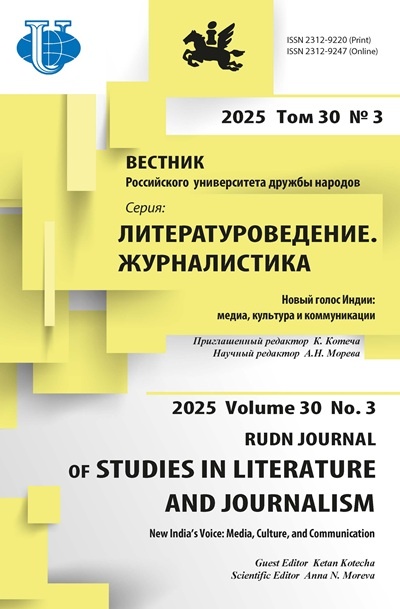ВОСПРИЯТИЕ И ФУНКЦИОНИРОВАНИЕ ПОЛИТИЧЕСКИХ МЕДИАПРИЕМОВ В СОЦИАЛЬНЫХ МЕДИА
- Авторы: Кузнецов И.С.1, Солдаткина Я.В.1
-
Учреждения:
- Московский педагогический государственный университет
- Выпуск: Том 22, № 2 (2017)
- Страницы: 333-339
- Раздел: Журналистика
- URL: https://journals.rudn.ru/literary-criticism/article/view/16753
- DOI: https://doi.org/10.22363/2312-9220-2017-22-2-333-339
- ID: 16753
Цитировать
Полный текст
Аннотация
Цель представленной статьи - анализ функционирования политических медиамемов, особенности их воздействия и восприятия аудиторией, их классификация и описание струк-туры виральных единиц. В ходе проведенного исследования авторы анализируют функцио-нирование и способы влияния медиамемов в российском сегменте интернета. Современные медиамемы имеют четкую структуру, позволяющую им активно реплицироваться в социальных медиа. Данная структура также позволяет исследователю классифицировать виральные еди-ницы для лучшего понимания принципов их функционирования и основного месседжа. Ав-торы приводят собственную классификацию политических медиамемов, подкрепляя акту-альными примерами последней президентской кампании в США. Успешные репликация и использование медиамемов в качестве инструмента воздействия на аудиторию могут зависеть от неврологических и психологических основ восприятия виральной информации. Сегодня политические медиамемы используются не только как единицы рекреативной сферы, но и как эффективный инструмент воздействия на аудиторию, пропаганды и политической аги-тации в ходе предвыборных кампаний.
Ключевые слова
Об авторах
Иван Сергеевич Кузнецов
Московский педагогический государственный университет
Автор, ответственный за переписку.
Email: kuznetsov0803@mail.ru
магистрант Института журналистики, коммуникаций и медиаобразования Московского педагогического государственного университета
Малая Пироговская, 1, Москва, Россия, 119991Янина Викторовна Солдаткина
Московский педагогический государственный университет
Email: yav.soldatkina@mpgu.edu
доктор филологических наук, профессор кафедры русской литературы Института филологии Московского педагогического университета
Малая Пироговская, 1, Москва, Россия, 119991Список литературы
- Dawkins R. The Selfish Gene. Oxford: Oxford University Press, 1989. 192 c.
- Rushkoff D. Media Virus: Hidden Agendas in Popular Culture. Ballantine Books, NY, 1996.
- Кузнецов И.С. Теоретическая классификация политических медиамемов // Путь к идеалу: сб. научн. тр., посвященных юбилею доктора филологических наук, профессора В.А. Славиной. М., 2016. С. 151-158.
- Bryant J., Thompson S. Fundamentals of Media Effects. McGraw-Hill, NY, 2002.
- Wolpert S. “How the brain creates the ‘buzz’ that helps ideas spread” // UCLA. URL: http:// newsroom.ucla.edu/releases/how-the-brain-creates-buzz-247204 (дата обращения: 05.03.2017).
- Mass Communication Theory // University of South Florida. URL: https://masscommtheory. com (дата обращения: 05.03.2017).
- Wiggins B. “How the Russia-Ukraine crisis became a magnet for memes” // The Conversation. URL: http://theconversation.com/how-the-russia-ukraine-crisis-became-a-magnet-formemes-31199 (дата обращения: 05.03.2017).
Дополнительные файлы















